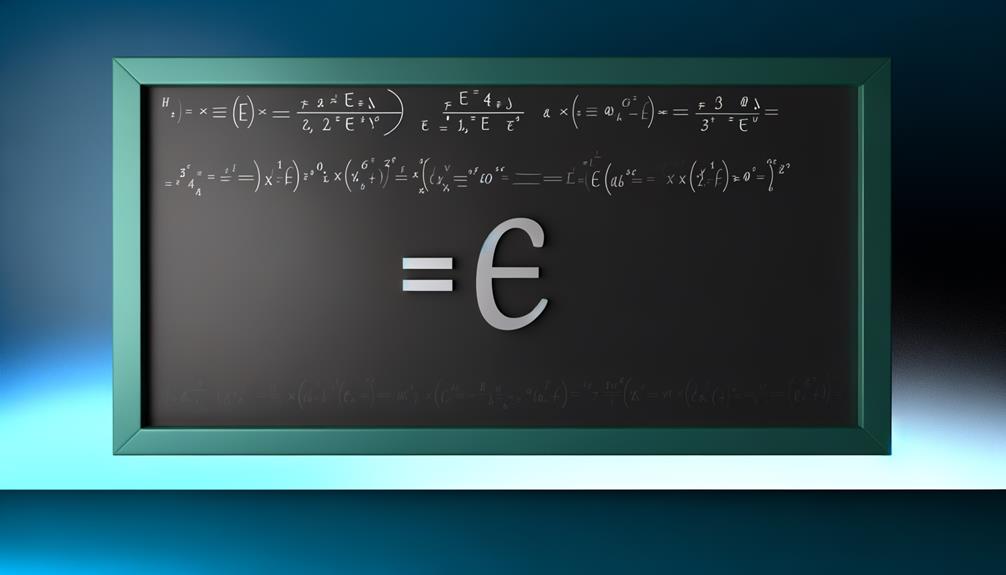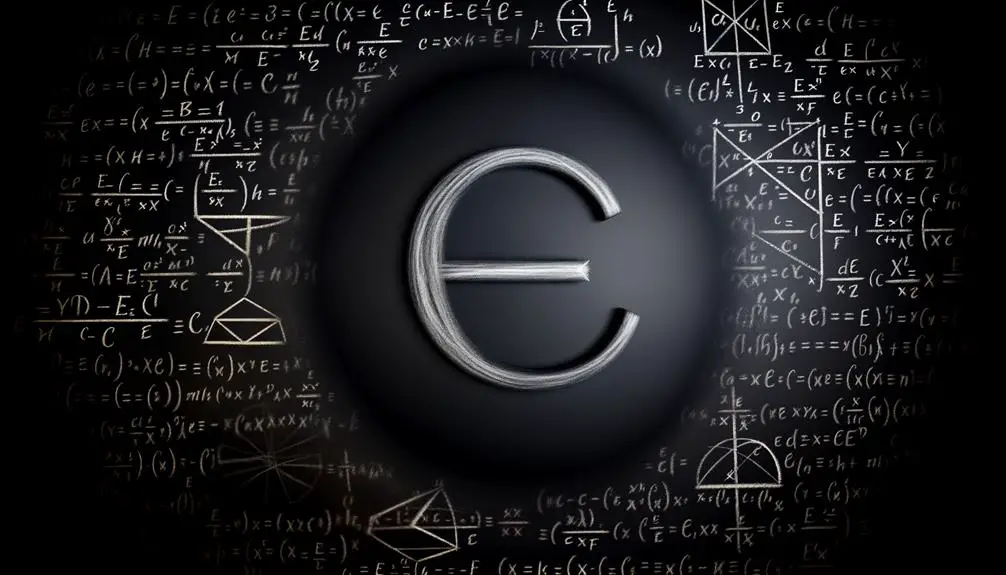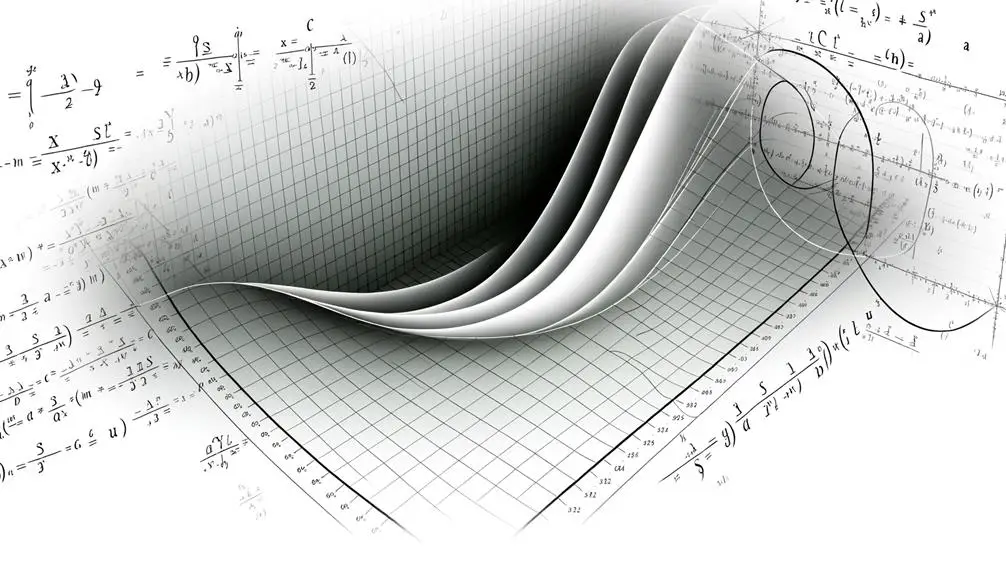What Does the E Symbol Mean in Math?
The mathematical constant 'e,' approximately 2.71828, is pivotal in understanding exponential growth, natural logarithms, and various fields of calculus. Originating from Jacob Bernoulli's study on compound interest, 'e' represents the limit of \( (1 + rac{1}{n})^n \) as \( n \) approaches infinity.
Leonhard Euler further established 'e' as the base of natural logarithms, linking it to complex analysis by connecting exponential functions with trigonometry. Unique properties, such as being the base of natural logarithms and having a Taylor series expansion that converges for all real numbers, underscore its significance.
Explore further to grasp its profound impact on mathematics.

Key Takeaways
- 'e' is the base of the natural logarithm, approximately equal to 2.71828.
- 'e' represents the limit of \( \lim_{n o \infty} (1 + rac{1}{n})^n \).
- 'e' is the unique number where the derivative of \( e^x \) at \( x = 0 \) is 1.
- 'e' models continuous growth and decay in various fields like finance and natural sciences.
- 'e' is irrational and transcendental, with an infinite continued fraction representation.
Origin of 'e'

The mathematical constant 'e' originated from the work of the Swiss mathematician Jacob Bernoulli in the context of compound interest calculations. Bernoulli was investigating the behavior of compound interest as the number of compounding intervals per year increased.
Through this exploration, he discovered that as the number of compounding periods approached infinity, the value approached a specific limit, now known as 'e'. This constant is approximately equal to 2.71828 and represents the base of the natural logarithm.
Its importance extends beyond finance, permeating various fields such as calculus, complex analysis, and differential equations. The discovery of 'e' fundamentally altered mathematical approaches to growth processes and decay, providing a cornerstone for continuous growth models.
Euler's Contribution
Leonhard Euler greatly advanced the understanding and applications of the constant 'e' by establishing its properties and integrating it into various mathematical frameworks.
Euler's work in the 18th century elucidated 'e' as the base of natural logarithms, solidifying its role in calculus. He demonstrated that the function \( e^x \) could be expanded into an infinite series, \( e^x = 1 + x + rac{x^2}{2!} + rac{x^3}{3!} + \cdots \), offering a profound insight into exponential growth and decay.
Euler also linked 'e' to complex analysis through Euler's formula, \( e^{ix} = \cos(x) + i\sin(x) \), bridging trigonometry and exponential functions. His contributions deeply embedded 'e' in mathematical theory, influencing both pure and applied mathematics.
Mathematical Definition

Defining the mathematical constant 'e' involves recognizing it as the unique real number such that the derivative of the function \( e^x \) at \( x = 0 \) is exactly 1. This definition is essential in calculus and mathematical analysis.
The constant \( e \), approximately equal to 2.71828, is fundamental in various branches of mathematics, including exponential growth and compound interest calculations.
Key points to understand about \( e \):
- It is the base of the natural logarithm.
- It can be defined as the limit \( \lim_{n o \infty} (1 + rac{1}{n})^n \).
- It appears in the solution of the differential equation \( rac{dy}{dx} = y \).
- It is irrational and transcendental.
- Its continued fraction representation is infinite.
Properties of 'e'
One of the most intriguing properties of the mathematical constant \( e \) is its role as the base of the natural logarithm, denoted as \( \ln(x) \). This property allows for unique and elegant simplifications in mathematical expressions and equations.
Additionally, \( e \) can be defined by the limit \( \lim_{n o \infty} \left(1 + rac{1}{n}\right)^n \), showcasing its inherent connection to continuous growth processes.
Another key property is that the function \( e^x \) is its own derivative, a rare attribute that underscores its significance in mathematical analysis.
Furthermore, the series expansion of \( e^x \) as \( \sum_{n=0}^{\infty} rac{x^n}{n!} \) converges for all real numbers \( x \), further highlighting \( e \)'s foundational role in various mathematical contexts.
'e' in Calculus

In calculus, Euler's number (e) serves as the base of the natural logarithm, providing a fundamental constant for exponential growth and decay processes.
Its unique properties enable the derivative of e^x to remain e^x, thereby simplifying the differentiation and integration of exponential functions.
This intrinsic relationship underscores the importance of e in modeling continuous growth and decay phenomena across various scientific disciplines.
Euler's Number Definition
Euler's number, denoted as \(e\), is a fundamental constant in mathematics, approximately equal to 2.71828, that arises naturally in the study of exponential growth and decay. This transcendental number is pivotal in various mathematical contexts and applications.
Key properties and uses of \(e\) include:
- The base of the natural logarithm, integral to calculus.
- The unique property where the function \(e^x\) is its own derivative.
- Essential in defining the exponential function \(e^x\), used extensively in differential equations.
- Appearing in compound interest calculations, modeling continuous growth.
- Integral to the formula for Euler's identity, \(e^{i\pi} + 1 = 0\), connecting \(e\), \(i\), and \(\pi\).
Understanding \(e\) enhances comprehension of exponential processes and growth phenomena.
Natural Logarithm Base
The natural logarithm base \(e\) serves as a cornerstone in the field of calculus, underpinning the logarithmic and exponential functions critical for advanced mathematical analyses.
Defined approximately as 2.71828, \(e\) arises naturally in the context of continuous growth processes.
The function \(e^x\), where \(e\) is the base and \(x\) the exponent, is unique in that its derivative is itself, signifying an intrinsic relationship between the function and its rate of change.
Additionally, the natural logarithm \(\ln(x)\) uses \(e\) as its base, simplifying the integration and differentiation of logarithmic expressions.
Therefore, \(e\) is indispensable in solving complex calculus problems, particularly in contexts requiring precise modeling of dynamic systems.
Growth and Decay
Exponential growth and decay phenomena are elegantly modeled using the mathematical constant \(e\), providing a robust framework for analyzing dynamic systems. In calculus, the function \(e^x\) serves as the cornerstone for understanding these processes.
The natural exponential function elucidates the continuous growth or decay of quantities over time.
Key applications include:
- Population growth: Models changes in population size.
- Radioactive decay: Describes the reduction of unstable isotopes.
- Compound interest: Calculates the growth of investments.
- Heat transfer: Analyzes temperature changes in materials.
- Pharmacokinetics: Predicts drug concentration in the bloodstream.
Through these applications, \(e\) demonstrates its utility in solving real-world problems, providing insightful analyses and precise predictions.
Exponential Functions
Exponential functions, characterized by the constant 'e', are fundamental components in various branches of mathematics and science. Their definition and properties form the basis for understanding their significance in modeling real-world phenomena such as population growth and radioactive decay.
Additionally, the graphical representation of exponential curves provides valuable insights into their behavior and applications.
Definition and Properties
In mathematics, the symbol 'e' represents the base of the natural logarithm and is approximately equal to 2.71828.
Exponential functions of the form \( e^x \) exhibit unique and essential properties in various mathematical contexts. These properties include:
- Continuous Growth: The function \( e^x \) is continuous and differentiable everywhere.
- Derivative and Integral: The derivative and integral of \( e^x \) are both \( e^x \), making it unique among exponential functions.
- Limit Definition: \( e \) can be defined as the limit of \((1 + rac{1}{n})^n\) as \( n \) approaches infinity.
- Euler's Formula: Relates complex exponentials to trigonometric functions, as \( e^{ix} = \cos(x) + i\sin(x) \).
- Compound Interest: Represents continuous compounding in finance.
These properties establish 'e' as a cornerstone in mathematical analysis.
Real-World Applications
Numerous real-world phenomena, from population growth to radioactive decay, can be accurately modeled using exponential functions involving the constant \( e \).
In population dynamics, the exponential model \( P(t) = P_0 e^{rt} \) describes how populations grow under ideal conditions, where \( P_0 \) is the initial population, \( r \) is the growth rate, and \( t \) is time.
Similarly, radioactive decay is modeled by \( N(t) = N_0 e^{-\lambda t} \), where \( N_0 \) is the initial quantity, and \( \lambda \) is the decay constant.
These applications underscore the significance of \( e \) in capturing continuous growth or decay, providing a robust framework for understanding complex natural processes quantitatively.
Graphing Exponential Curves
Plotting the graph of an exponential function requires understanding its distinctive features, such as its rapid growth or decay and its horizontal asymptote. Exponential functions, typically expressed as f(x) = a * e^(bx), where 'e' is Euler's number, exhibit unique behaviors that set them apart from other functions.
Key characteristics include:
- Horizontal Asymptote: The curve approaches but never touches the horizontal axis.
- Rapid Growth/Decay: Depending on the sign of 'b', the function shows swift increase or decrease.
- Intercept: The y-intercept occurs at (0, a) since e^0 = 1.
- Domain and Range: The domain is all real numbers, while the range is positive real numbers.
- Concavity: The graph is concave up if 'b' is positive and concave down if 'b' is negative.
Understanding these traits is pivotal for accurate graphing.
Natural Logarithms

Natural logarithms, denoted as ln(x), play a crucial role in mathematical analysis and scientific calculations by providing a means to express relationships involving exponential growth and decay. Unlike common logarithms, which use base 10, natural logarithms use the base e, an irrational constant approximately equal to 2.71828. This base is fundamental in fields such as calculus, physics, and engineering due to its unique properties.
Here is a comparison of common logarithm and natural logarithm values:
| x | log₁₀(x) | ln(x) |
|---|---|---|
| 1 | 0 | 0 |
| 10 | 1 | 2.3026 |
| 100 | 2 | 4.6052 |
| 1000 | 3 | 6.9078 |
Understanding ln(x) is crucial for solving differential equations and modeling natural phenomena.
'e' in Complex Analysis
In complex analysis, the constant e plays a pivotal role in defining the exponential function for complex numbers, leading to profound implications in the field. The function \( e^{z} \), where \( z \) is a complex number, is essential in solving complex differential equations and analyzing periodic functions. This function can be expressed using Euler's formula \( e^{ix} = \cos(x) + i\sin(x) \), showcasing the deep connection between exponential functions and trigonometry. Key properties include:
- Analyticity: \( e^z \) is entire, meaning it is differentiable everywhere in the complex plane.
- Periodicity: \( e^{z + 2\pi i} = e^z \), indicating a periodic nature.
- Conformal Mapping: It preserves angles locally.
- Growth Rate: Exhibits rapid growth as \( |ext{Re}(z)| \) increases.
- Inverse Function: Natural logarithm \( \ln(z) \).
Real-World Applications

The mathematical constant \( e \) finds extensive real-world applications in fields ranging from finance to engineering, where its properties facilitate various complex calculations and models. In finance, \( e \) is instrumental in modeling exponential growth or decay, such as compound interest calculations. In engineering, it is used in the analysis of systems involving exponential signal decay or growth. Additionally, \( e \) is pivotal in probability theory, particularly in the context of continuous probability distributions like the normal distribution. Its applications extend to natural sciences, where it describes phenomena like radioactive decay and population dynamics.
| Field | Application |
|---|---|
| Finance | Compound interest, exponential growth models |
| Engineering | Signal processing, control systems |
| Probability | Continuous distributions, risk modeling |
| Natural Sciences | Radioactive decay, population dynamics |
Conclusion
The mathematical constant 'e' plays an essential role across various domains of mathematics, including calculus, exponential functions, and complex analysis. Its origin is rooted in the study of compound interest, and it was notably advanced by Euler.
One notable statistic is that 'e' approximately equals 2.71828, a value that appears in diverse scientific contexts, from financial models to population growth. Understanding 'e' enhances comprehension of natural logarithms and continuous growth processes, emphasizing its fundamental importance in both theoretical and applied mathematics.






